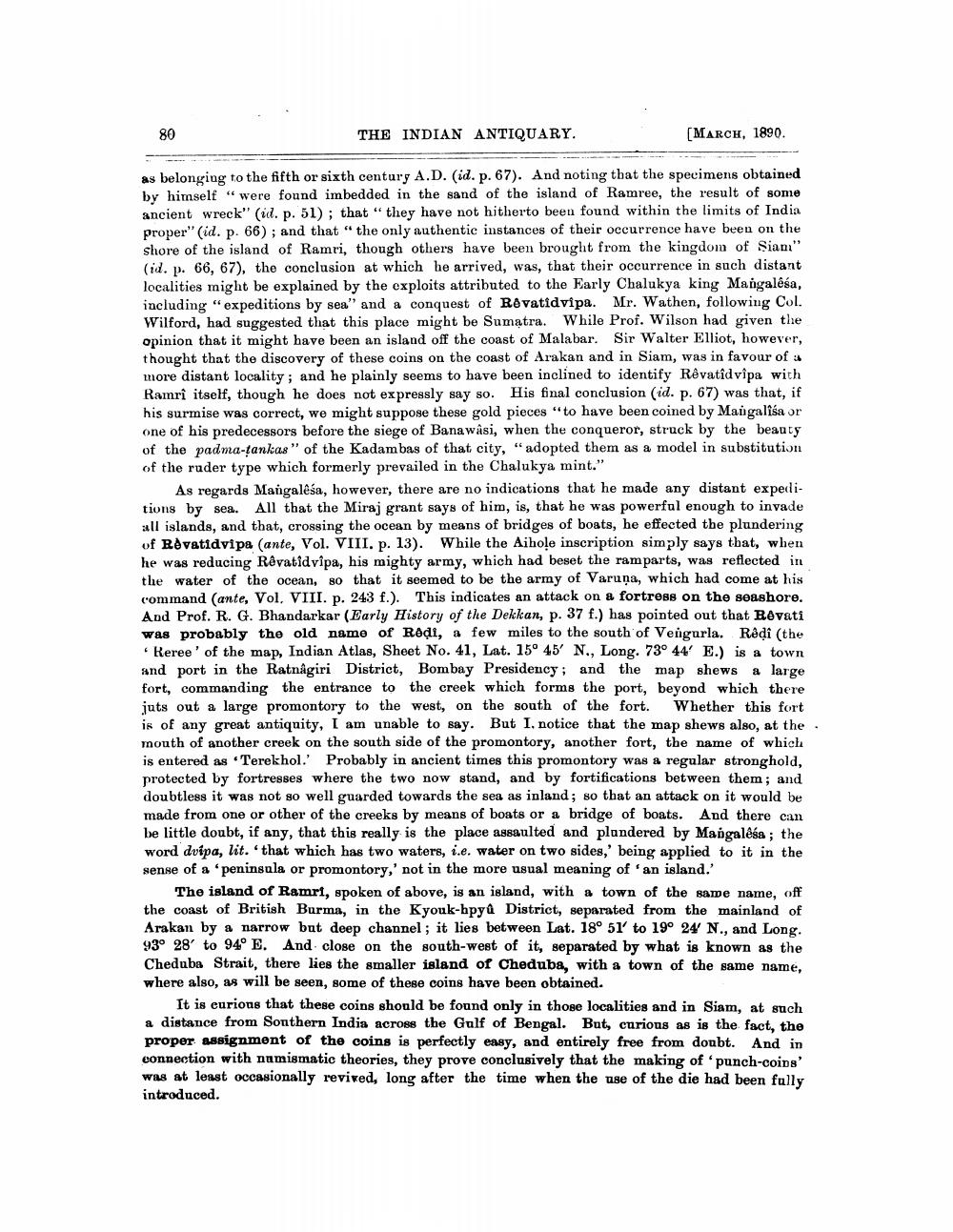________________
THE INDIAN ANTIQUARY.
[MARCH, 1890.
as belonging to the fifth or sixth century A.D. (id. p. 67). And noting that the specimens obtained by himself " were found imbedded in the sand of the island of Ramree, the result of some ancient wreck" (id. p. 51); that "they have not hitherto been found within the limits of India proper" (id. p. 66); and that "the only authentic instances of their occurrence have been on the shore of the island of Ramri, though others have been brought from the kingdom of Siam" (id. p. 66, 67), the conclusion at which he arrived, was, that their occurrence in such distant localities might be explained by the exploits attributed to the Early Chalukya king Mangalêsa, including "expeditions by sea" and a conquest of Rövatidvipa. Mr. Wathen, following Col. Wilford, had suggested that this place might be Sumatra. While Prof. Wilson had given the opinion that it might have been an island off the coast of Malabar. Sir Walter Elliot, however, thought that the discovery of these coins on the coast of Arakan and in Siam, was in favour of : more distant locality; and he plainly seems to have been inclined to identify Rêvatîdvîpa with Ramri itself, though he does not expressly say so. His final conclusion (id. p. 67) was that, if his surmise was correct, we might suppose these gold pieces "to have been coined by Maugalisa or one of his predecessors before the siege of Banawasi, when the conqueror, struck by the beauty of the padma-tankas" of the Kadambas of that city, "adopted them as a model in substitution of the ruder type which formerly prevailed in the Chalukya mint."
As regards Mangalêśa, however, there are no indications that he made any distant expeditions by sea. All that the Miraj grant says of him, is, that he was powerful enough to invade all islands, and that, crossing the ocean by means of bridges of boats, he effected the plundering of Revatidvipa (ante, Vol. VIII. p. 13). While the Aihole inscription simply says that, when he was reducing Rêvatidvipa, his mighty army, which had beset the ramparts, was reflected in the water of the ocean, so that it seemed to be the army of Varuņa, which had come at his command (ante, Vol. VIII. p. 243 f.). This indicates an attack on a fortress on the seashore. And Prof. R. G. Bhandarkar (Early History of the Dekkan, p. 37 f.) has pointed out that Bovati was probably the old name of Roại, a few miles to the south of Vengurla. Radi (the * Reree' of the map, Indian Atlas, Sheet No. 41, Lat. 15° 45' N., Long. 73° 44' E.) is a town and port in the Ratnagiri District, Bombay Presidency; and the map shews a large fort, commanding the entrance to the creek which forms the port, beyond which there juts out a large promontory to the west, on the south of the fort. Whether this fort is of any great antiquity, I am unable to say. But I. notice that the map shews also, at the . mouth of another creek on the south side of the promontory, another fort, the name of which is entered as Terekhol.' Probably in ancient times this promontory was a regular stronghold, protected by fortresses where the two now stand, and by fortifications between them; and doubtless it was not so well guarded towards the sea as inland; so that an attack on it would be made from one or other of the creeks by means of boats or a bridge of boats. And there can be little doubt, if any, that this really is the place assaulted and plundered by Mangalêsa; the word dvipa, lit. that which has two waters, i.e. water on two sides,' being applied to it in the sense of a 'peninsula or promontory,' not in the more usual meaning of an island.
The island of Ramri, spoken of above, is an island, with a town of the same name, off the coast of British Burma, in the Kyouk-hpyû District, separated from the mainland of Arakan by a narrow but deep channel; it lies between Lat. 18° 51' to 19° 24' N., and Long. 93° 28' to 940 E. And close on the south-west of it, separated by what is known as the Cheduba Strait, there lies the smaller island of Cheduba, with a town of the same name, where also, as will be seen, some of these coins have been obtained.
It is curious that these coins should be found only in those localities and in Siam, at such a distance from Sonthern India across the Gulf of Bengal. But, curious as is the fact, the proper assignment of the coins is perfectly easy, and entirely free from doubt. And in connection with numismatic theories, they prove conclusively that the making of 'punch-coins' was at least occasionally revived, long after the time when the use of the die had been fully introduced.




